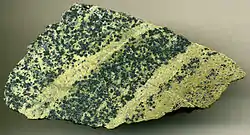Ophiolite
An ophiolite is a section of the Earth's oceanic crust and the underlying upper mantle that has been uplifted and exposed above sea level. The rocks which make up ophiolites are an altered form of basalt.[1] The rocks are often green.

Ophiolitic serpentinite from Austria, originally from the Proterozoic-early Paleozoic upper mantle. This peridotite rock was metamoposed in later mountain ranges

Cross-section of an ophiolite
They are found in the mountain belts such as the Alps or the Himalayas. They show where former ocean basins were consumed by subduction. This was one of the discoveries of plate tectonics. Ophiolites have always played a central role in plate tectonic theory and the interpretation of ancient mountain belts.[2]
Stratigraphy and definition

Idealized stratigraphic sequence of an ophiolite
The stratigraphic sequence seen in ophiolites is caused by lithosphere-forming processes at mid-oceanic ridges:
- Sediments: muds (black shale) and cherts deposited after the crust formed.
- Extrusive sequence: basalt "pillow lavas" show magma/seawater contact.
- Vertical, parallel dikes fed lavas above.
- Gabbros from minerals settling from a magma chamber.
- Peridotite: mantle rock minerals, heated and pressured in orogeny (mountain-building).
Notable ophiolites
- In the California Coast Ranges, from Santa Barbara through San Francisco Counties, California.
- In Oman and the United Arab Emirates, widely considered one of the best exposed ophiolite sequences
- Macquarie Island, Tasmania, Australia was named a UNESCO World Heritage Site in 1997, as the only known example of an ophiolite complex in the process of being formed and currently in its original geological setting.
- In Gros Morne National Park, Newfoundland, named a UNESCO World Heritage Site in 1987 because of its superbly exposed complete ophiolite stratigraphic sequence
References
- Ben-Avraham Z. et al 1982. The emplacement of ophiolites by collision. Journal of Geophysical Research: Solid Earth (1978-2012). 87 (B5) 3861-3867.
- Dilek Y. 2003. Ophiolite concept and its evolution. In Dilek Y. & Newcomb S. Ophiolite concept and the evolution of geological thought. Special Paper 373. Geological Society of America. pp. 1–16 . ISBN 0813723736
This article is issued from Wikipedia. The text is licensed under Creative Commons - Attribution - Sharealike. Additional terms may apply for the media files.